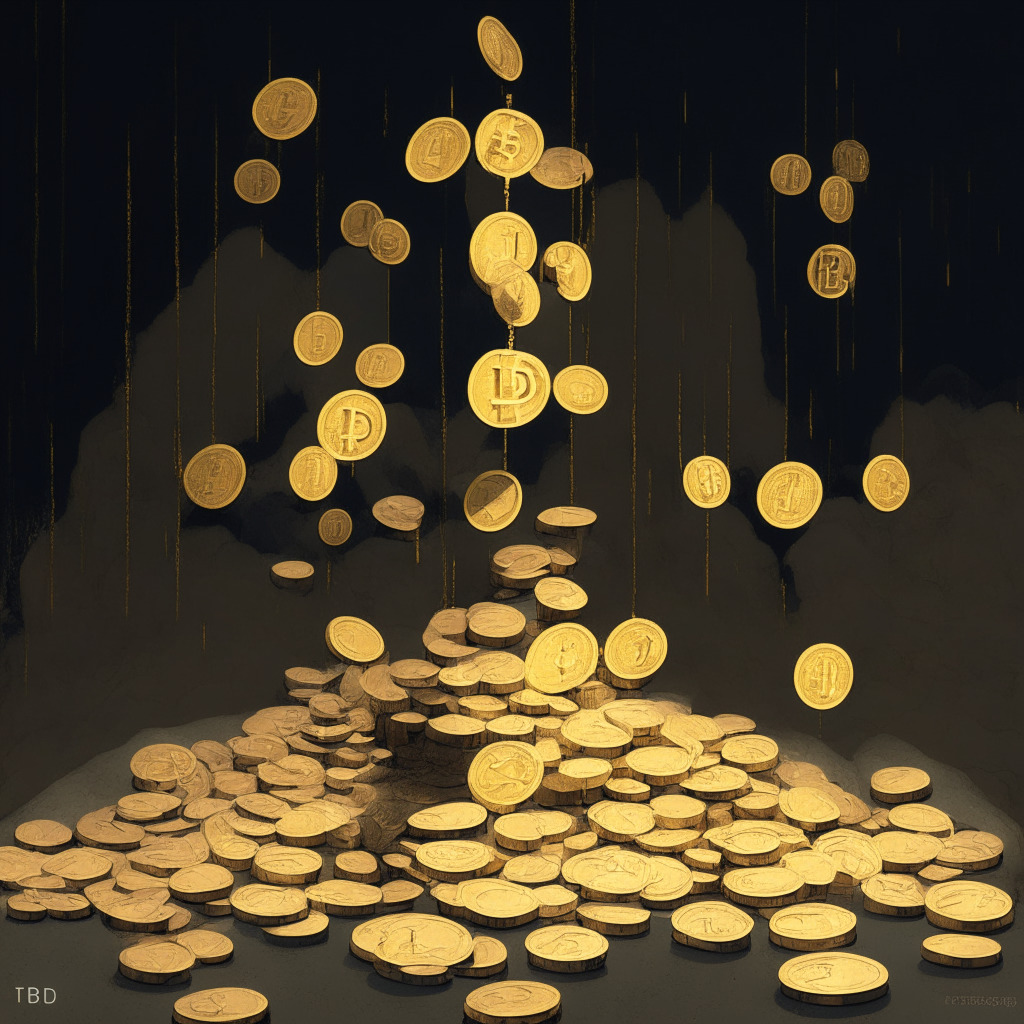The United States Government Accountability Office (GAO) report cites poor governance and unsatisfactory risk-management practices as primary causes of Signature Bank’s failure in March, acknowledging the bank’s exposure to the crypto industry as a potential contributing factor. The continued debate on the role of crypto in failed banks’ circumstances directly affects the fintech and regulatory spaces.
Search Results for: Silicon
Mandating Full Crypto Holdings Disclosure: Basel Committee’s Bold Move towards Transparency
The Basel Committee on Banking Supervision intends to mandate banks to disclose their cryptocurrency holdings fully, aiming to bolster transparency. They will detail disclosure requirements for bank’s exposure to crypto assets, with the objective to prevent potential risks within the financial ecosystem. Using this approach, the committee hopes to create increased crypto transparency.
Unraveling Stablecoins: Booming Assets or Impending Crisis?
“This report by the United States Federal Reserve Banks reveals the potential impact of stablecoins on the economy. Highlighting the similarity between stablecoins and money market funds, it warns of the vulnerabilities these coins face during market downturns. Issues like risky backing collateral and erosion of investor confidence can lead to substantial losses.”
Kraken’s Expansion in Europe: Spearheading the Crypto Revolution with Key Regulatory Approvals
Crypto exchange Kraken has secured regulatory approvals in Spain and Ireland, furthering its expansion plans in Europe. With a Virtual Asset Service Provider license and an EU e-money license, Kraken will provide digital asset exchange and custodial wallet services.Investment into regulatory framework positions Europe as a promising arena for crypto growth.
Ripple’s Expansion in the UK: Crypto Boom or Regulatory Burden?
Ripple, a US fintech and blockchain firm, is expanding its British presence amidst regulatory challenges in the US. This follows the UK’s strategic efforts to become a global hub for crypto and fintech firms, including legislation regulating cryptocurrencies and stablecoins. Critics, however, fear this may limit open innovation.
Investment Contenders Eye SVB Capital: A Beneficial Shift or a Potential Threat for Crypto Market?
“Investment contenders are vying to acquire SVB Capital, a key backer for crypto-focused venture capital firms. Despite potential market dilution due to an increased number of crypto funds, large financial institutions like Citigroup are adopting blockchain, signalling mainstream integration of the technology.”
Dwindling Stablecoin Dominance: A Strategic Investor Shift or a Market Trend?
“Stablecoins have experienced a 17-month decline, losing market dominance by 11.6%, with a total sector drop of $124 billion. Despite this, stablecoin trading volume has grown by 10.9%. Some propose investors are cashing out stablecoins to diversify into traditional assets due to rising yields in fixed-income securities and cryptocurrencies. This pivot raises questions about the future behavior of the crypto market.”
Decoding the Legal Fray: Fenwick, FTX and the Boundaries of Crypto Accountability
“Fenwick & West, a Silicon Valley law firm, is accused of involvement in a fraud involving the insolvent crypto marketplace, FTX. The firm asserts its services were within legal realms and lacked awareness of fraudulent actions. The case underscores the complexities of cryptocurrency and brings focus on stakeholder accountability.”
Unraveling the Future of a Decentralized Economy: Pros and Cons of Crypto Finance
“Bitcoin and decentralized finance (DeFi) offer a financial alternative to conventional systems, providing a solution to issues like inflation and institutional insolvency. However, challenges like Central Bank Digital Currencies (CBDCs), centralized exchanges, and global instability could impact DeFi’s potential benefits”
Stablecoin De-Pegging: A Deep-Dive into USDC and DAI Performance versus USDT and BUSD
“Analysts reveal ‘de-pegging’ is more common in stablecoins USDC and DAI compared to Tether and Binance USD. While stability ideally requires good governance, collateral and reserves, market confidence and adoption, USDT has shown steadiness despite mainstream scrutiny.”
Fear, Uncertainty, Doubt: Unexpected Catalysts for Crypto Price Rallies?
“Digital assets show potential for price rallies amid market uncertainty, reports cryptocurrency analytics firm Santiment. Increased Fear, Uncertainty, and Doubt (FUD) sentiments often lead to price boosts within cryptocurrencies. This trend witnessed Ethereum’s price rise 48% following a FUD incident.”
Rollercoaster Predictions: Bitcoin’s Potential Rise to $22K Amidst Market Uncertainty
“Despite the gloomy market sentiment and legal hurdles from SEC, market analysts forecast Bitcoin could hit the $22K mark. U.S. inflation drop and Federal Reserve’s liquidity drainage could push investors to alternative assets like Bitcoin. However, serious challenges still remain.”
Ethereum’s Struggle: Battling Market Fear Amid Shaky Support Levels
Despite Ethereum’s 31.3% price surge between March 10 and 18, there are concerns about the crypto’s ability to maintain this upward momentum. Rising bearish sentiment, decreases in key ETH price metrics, and negative market developments are troubling the ecosystem. There are fears over potential liquidation of some $4.8 billion ETH deposits held in the Grayscale Ethereum Trust, amid declining smart contract transactions and investor interest. Ethereum’s position is further pressured by its competitors like Visa integrating Solana blockchain and Coinbase planning to convert old versions of USDC to a new format.
Worldcoin’s Privacy Protocols Under Scrutiny: Balancing Innovation and User Safety
The unanticipated inspection of Paris-based Worldcoin’s office by France’s data watchdog, the CNIL, has intensified debates over its privacy protocols. This event underscores the strict scrutiny crypto projects are subjected to and the growing worries surrounding user privacy and data storage.
Tether’s Banking Partnerships: An Advance Toward Global Inclusivity or a Regulatory Nightmare?
Tether, the issuer of popular stablecoin USDT, has partnered with Britannia Bank & Trust, a private bank based in The Bahamas, for processing dollar transfers. Notwithstanding critics’ doubts over the assets backing the $86 billion held by Tether, it accounts for around 66.5% of the total stablecoin market.
FTX Founder’s High-Stakes Trial: Decoding the Intricacies in Cryptocurrency Lawsuit Precedents
FTX founder Sam Bankman-Fried (SBF) is facing legal difficulties involving fraud and improper use of customers’ funds, which allegedly included billions of dollars from FTX users to offset losses at his hedge fund and make extensive political contributions. This case could potentially set a precedent for future high-profile crypto scams.
Upcoming Jackson Hole Symposium: A Turning Point for Bitcoin’s Market Turmoil?
“The markets face potential volatility amidst concerns of Bitcoin’s latest price changes, affected by rising unrealized losses and external factors such as statements at the Jackson Hole Economic Symposium. Despite investor fear and the recent 11% BTC drop, historical patterns suggest potential for robust recovery.”
Navigating the Stablecoin Storm: The Push for Regulation Amid Market Instability
Circle’s Chief Strategy Officer, Dante Disparte, emphasizes the need for federal regulation of stablecoins amid market volatility and banking mishaps. Amidst concerns of “counterfeit US dollars using cryptographic methods”, Disparte sees regulation as a safeguard for investors and a protection of monetary policy.
Auradine’s Stunning $81 Million Debut Funding: Bold Vision or Just a Polished Pitch Deck?
Crypto startup, Auradine remarkably secured $81 million in its first funding round without a product or a single customer. The vision is to fabricate hardware for Bitcoin mining, enhanced cryptography, and artificial intelligence. The company also attracted “inbound interest for a follow-on round of funding.”
Regulatory Shift: The Stifling or Stability of Cryptocurrency in U.S. Banking
“The U.S. FDIC’s latest risk report indicates a shift from previously indifferent stance towards considering cryptocurrency as an area of concern. The 2023 Risk Review shows FDIC’s readiness to initiate discussions with banks about crypto-asset activities, echoing similar sentiments across U.S. banking agencies. Yet, it also reveals the complex balancing act required in integrating digital assets safely into the conventional banking system.”
FDIC Highlights Crypto Risk: The Crossroads of Innovation and Vulnerability
“In an act of unprecedented vigilance, the United States banking system has been alerted to the ‘novel and complex’ risks presented by cryptocurrencies, highlighted in a recent report by the Federal Deposit Insurance Corporation (FDIC). The FDIC has demarcated a critical area regarding digital assets risk in its annual risk review, focusing on the burgeoning and volatile crypto market.”
PayPal’s Stablecoin Revolution: Evolving Crypto Landscape with Regulatory Safeguards
PayPal launches its own stablecoin, PYUSD, representing a pioneering move in bringing regulatory oversight and customer asset protection to the crypto world. The coin, developed with Paxos, is closely monitored by the New York Department of Financial Services to secure it against bankruptcy risks.
Exploring Tether’s Financial Dance: A Dip Below 1:1 Peg Puzzles Market Analysts
The USD-pegged stablecoin, Tether (USDT), recently dropped slightly under its 1:1 peg against the US dollar on the DEX Curve Finance, upsetting the primary stablecoin liquidity pool balance. Despite concerns, Tether continues to boost transparency by publishing the value of its reserves daily, helping maintain confidence in its stablecoin’s backing by USD or liquid-equivalent reserves.
Unpacking the Unusual Dynamics: USDT’s Massive Sell-Off Raises Questions and Uncertainties
“USDT, a widely used stablecoin, saw a significant discharge from crypto traders’ wallets, especially on Curve Finance and UniSwap exchanges. This event caused USDT’s price to drop below its usual $1 peg. This indicates that under certain circumstances, investors may prefer holding DAI or USDC rather than USDT.”
Charting the Future with Worldcoin: Revolutionizing Crypto and Global Identity or Igniting Privacy Concerns?
Worldcoin is a high-profile project blending cryptocurrencies, AI, and blockchain technology to establish a global, transparent identity and commerce system. A unique feature, World ID, utilizes an eye-scanning device that distinguishes human identity from AI robots, while also paving the way for decentralized, token-based commerce and potential income equality solutions.
Banking Crisis Ripple: Heartland Tri-State Bank’s Collapse & Its Implications on Industry Safety
“The disruption in the U.S. banking sector, illustrated by the recent collapse of Heartland Tri-State Bank, is attributed to rising U.S. interest rates and inadequate risk management. This crisis highlights a need for improved banking system safety measures and increased bank executive accountability.”
Stablecoins: A Safer Alternative to Banking or a Risky Proposition?
“Brendan Malone, a former Federal Reserve Board analyst, posits stablecoins might pose less risk than traditional bank deposits. Stablecoins, such as Tether’s USDT and Circle’s USD Coin, offer an efficiency-laden alternative to traditional banking, given its insulation from the typical crypto volatility.”
Stablecoins Disrupting Financial System: Are They Really Riskier than Bank Deposits?
According to former Federal Reserve Board analyst, Brendan Malone, stablecoins are less risky than bank deposits and are not akin to money market funds. He argues that stablecoins, backed by fiat currencies and typically short-dated Treasuries, do not pose similar risks as banks due to the absence of mismatches between short-term liabilities and long-term assets. Regulating stablecoins similarly to traditional financial entities could, however, limit competition and increase market dominance.
Blockchain’s Impact on Traditional Banking: Analyzing the PacWest and Banc of California Merger
“The PacWest-Banc of California merger, backed by a $400 million equity injection from Warburg Pincus and Centerbridge, promises resilience amidst unstable banking conditions. However, the rapidly evolving landscape of decentralized financial systems like blockchain challenges the sustainability of traditional banking models.”
Cerebras and G42’s AI Supercomputer Partnership: A Game Changer or Risky Gamble?
“Cerebras Systems partners with UAE-based G42 to create a $100M AI supercomputer, possibly generating up to 36 exaFLOPs of AI computing. This could revolutionize sectors like healthcare and energy. However, American manufacturing and competitive challenges could disrupt plans.”
Bolstering Blockchain: The Integration of ZK Proofs in Cryptographic Technologies
This article discusses the partnership between Paris-based =nil; Foundation and Fabric Cryptography as they work together to enhance cryptographic technologies and accelerate the deployment of zero-knowledge (ZK) proofs – a cryptographic procedure with substantial privacy-preserving attributes. They aim to overcome barriers in computation, making ZK proofs more functional for digital transactions, cloud services and privacy applications.
Shima Capital Navigates Barbell Crypto Market: Gaming & Web3 Startups Amid Market-Turbulence
“Shima Capital founder, Yida Gao observes the cryptocurrency market’s analogy to a barbell, with infrastructure deals and consumer apps like gaming on either end. Although concerning for some, established crypto funds and market-valuation volatility propelled Shima to invest early in Web3 companies’ lifecycle stages, hence proving to be a safe haven.”






























